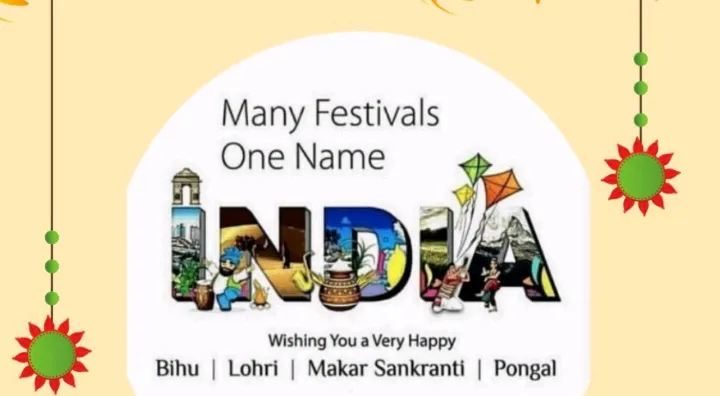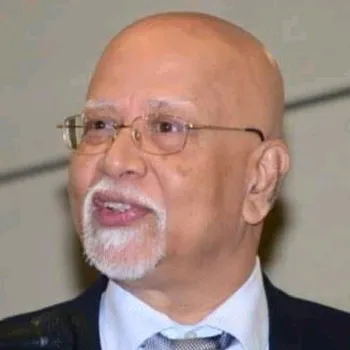Monsoon Murmurs 21
Pongal is an ancient festival. It is essentially a social festival crossing the borders of religion. Tamils of all religious faith celebrate Pongal. In Nandu's village the preparations for Pongal begins a week earlier. A team of youngsters join together to clean the house, throw out old things and paint the home. It was essentially, a white wash with calcite. The heated calcite was bought at specific furnace at some remote place. After severe heating the calcium carbonate becomes soluble in water. When one throws the cakes on water it boils, heating water. Since it is heavily alkaline one should be careful not to touch it. But a diluted solution of it is used to paint the house. There was no brush of modern types in those days. So the fibrous coconut shell was used as a brush. In front of the house stripes of white and red colors are painted. The red color comes from red soil rich in iron. Inside the house only white calcite is painted. In a way, it is important to clean the house for painting and all the unwanted accumulation was removed and burnt in from of the house. This is called Bogi or Indira vizha. The proper Pongal is the next day.
Pongal means something that froths. Pongal is prepared outside on a decorated place where rice was cooked with lentil on a sugary syrup in milk. On heating it froths. When it is thoroughly cooked with cashews, dried grapes (kismis) it is called Pongal. The pot that cooks this Pongal is holy and so tied with fresh turmeric leaves, decorated with holy symbols painted on it. Since is thanksgiving to Sun, it is held outside on a decorated place with kolam on the floor. Kolam is an art using white rice powder on the floor. The rice pieces will be eaten by ants. Sugarcanes are placed along which will be eaten later. The chewed sugar cane pieces become food for ants and other insects.
When the rice froths from Pongal panai (earthen pot), everyone chant, "pongalo Pongal", let new prosperity arrives and make one happy. In fact, Pongal is so generic that when Tamils begin any celebration in a temple they cook
Pongal. However, the biggest festival in Tamilnadu is Pongal. It is celebrated through out India in different names.
Nandu loves karumbu or sugarcane. He could eat one whole cane alone. That much fond of it. Since Nandu's father was a revenue officer, they get special brown sugar from the local factory called, " sakkarai alai". Nandu loves visiting this factory as this technique is as old as a big temple around, several centuries old. There are two varieties of sugarcane. One variety which is hard to peel by mouth is what used for making sugar. The other one is candy sugarcane. It is exactly like a candy, easily broken by teeth. The first one is green in color and the other one is dark violet in color.
The day after Pongal is a celebration of cows and bulls. Again thanksgiving to the cattle, a long associate of mankind.
Unlike Deepavali which is more personal, Pongal is a social event held outside home, open to everyone. In fact, Muslim sufis used to visit every home, get gifts and bless them. Churches celebrate Pongal as well. So, in a village life Pongal attracts more attention than Deepavali. On those days, cards are printed only for greeting Pongal and Nandu and his sisters receive Pongal card from friends and relatives. The more cards you receive, the more popular you are. Nandu ties a thread and hangs all his cards, so much to display. Deepavali card became popular only later. The post man and the entire post office will be flooded with greeting cards. Naturally, when post man delivers he receives gifts and cash.
Though boys and girls receive new cloths on Deepavali, on Pongal day one wears traditional cloths like veshti and sattai. Girls wear half saree and blouse. Landlords offer new cloths to agricultural employees on Pongal. In a way Pongal is an agricultural festival and most of India is very much an agricultural country. So, Pongal gains special importance. Nandu visits his Dalit friends on that day. Their houses are situated outside the villages called Paraicheri. Ancient literature in Tamil mentions about streets or conclaves called 'cheri'. For example 'parpana cheri' or brahmin's conclave is always closed to temples as priesthood is their main profession. Parai cheri is usually close the fields where farmers work.
The caste system has isolated people into conclaves avoiding any mixing. In a strange way, Nandu was instructed not to visit other conclaves as unwanted activities will be seen, especially killing of cow or goat. Nandu was instructed not to see any cruel acts. However, in modern India such restrictions are always loosened easily and Nandu visits during Pongal times his friends in other conclaves and happened to see goats hung on butcher's shop upside down skin peeled. It was awful seeing such sights. A chicken will be killed with lots of noise and unfeathered. These were sights that ought to be avoided by his caste rules. Though Nandu has overruled such restrictions he remained a vegetarian through out his life. Killing is wrong, so says Thiruvalluvar, the moral rishi of Tamils. He states if you follow ahimsa all beings will worship you as their lord. In spite of such moral codes Tamils remained violent.
Violence erupts with out notice in a village. Most of them are caste based or ego based. Hands are cut or other organs removed. Once a body was hung on the banyan tree close to the river. In fact, a muniswara was worshipped under that tree. Police investigation revealed later that it was not a suicide but a murder where the man's scrotum was squeezed. Nandu knows the pain of a scrotum being squeezed! He was hit once at the corner of a table. He thought he was dead for a moment. No wonder one could kill a man easily by squeezing his scrotum. In an odd morning Nandu witnessed a murder on the street while he was going to the school. It was gruesome.
Life is a celebration when there is no violence.
© nanu
Pongal means something that froths. Pongal is prepared outside on a decorated place where rice was cooked with lentil on a sugary syrup in milk. On heating it froths. When it is thoroughly cooked with cashews, dried grapes (kismis) it is called Pongal. The pot that cooks this Pongal is holy and so tied with fresh turmeric leaves, decorated with holy symbols painted on it. Since is thanksgiving to Sun, it is held outside on a decorated place with kolam on the floor. Kolam is an art using white rice powder on the floor. The rice pieces will be eaten by ants. Sugarcanes are placed along which will be eaten later. The chewed sugar cane pieces become food for ants and other insects.
When the rice froths from Pongal panai (earthen pot), everyone chant, "pongalo Pongal", let new prosperity arrives and make one happy. In fact, Pongal is so generic that when Tamils begin any celebration in a temple they cook
Pongal. However, the biggest festival in Tamilnadu is Pongal. It is celebrated through out India in different names.
Nandu loves karumbu or sugarcane. He could eat one whole cane alone. That much fond of it. Since Nandu's father was a revenue officer, they get special brown sugar from the local factory called, " sakkarai alai". Nandu loves visiting this factory as this technique is as old as a big temple around, several centuries old. There are two varieties of sugarcane. One variety which is hard to peel by mouth is what used for making sugar. The other one is candy sugarcane. It is exactly like a candy, easily broken by teeth. The first one is green in color and the other one is dark violet in color.
The day after Pongal is a celebration of cows and bulls. Again thanksgiving to the cattle, a long associate of mankind.
Unlike Deepavali which is more personal, Pongal is a social event held outside home, open to everyone. In fact, Muslim sufis used to visit every home, get gifts and bless them. Churches celebrate Pongal as well. So, in a village life Pongal attracts more attention than Deepavali. On those days, cards are printed only for greeting Pongal and Nandu and his sisters receive Pongal card from friends and relatives. The more cards you receive, the more popular you are. Nandu ties a thread and hangs all his cards, so much to display. Deepavali card became popular only later. The post man and the entire post office will be flooded with greeting cards. Naturally, when post man delivers he receives gifts and cash.
Though boys and girls receive new cloths on Deepavali, on Pongal day one wears traditional cloths like veshti and sattai. Girls wear half saree and blouse. Landlords offer new cloths to agricultural employees on Pongal. In a way Pongal is an agricultural festival and most of India is very much an agricultural country. So, Pongal gains special importance. Nandu visits his Dalit friends on that day. Their houses are situated outside the villages called Paraicheri. Ancient literature in Tamil mentions about streets or conclaves called 'cheri'. For example 'parpana cheri' or brahmin's conclave is always closed to temples as priesthood is their main profession. Parai cheri is usually close the fields where farmers work.
The caste system has isolated people into conclaves avoiding any mixing. In a strange way, Nandu was instructed not to visit other conclaves as unwanted activities will be seen, especially killing of cow or goat. Nandu was instructed not to see any cruel acts. However, in modern India such restrictions are always loosened easily and Nandu visits during Pongal times his friends in other conclaves and happened to see goats hung on butcher's shop upside down skin peeled. It was awful seeing such sights. A chicken will be killed with lots of noise and unfeathered. These were sights that ought to be avoided by his caste rules. Though Nandu has overruled such restrictions he remained a vegetarian through out his life. Killing is wrong, so says Thiruvalluvar, the moral rishi of Tamils. He states if you follow ahimsa all beings will worship you as their lord. In spite of such moral codes Tamils remained violent.
Violence erupts with out notice in a village. Most of them are caste based or ego based. Hands are cut or other organs removed. Once a body was hung on the banyan tree close to the river. In fact, a muniswara was worshipped under that tree. Police investigation revealed later that it was not a suicide but a murder where the man's scrotum was squeezed. Nandu knows the pain of a scrotum being squeezed! He was hit once at the corner of a table. He thought he was dead for a moment. No wonder one could kill a man easily by squeezing his scrotum. In an odd morning Nandu witnessed a murder on the street while he was going to the school. It was gruesome.
Life is a celebration when there is no violence.
© nanu




